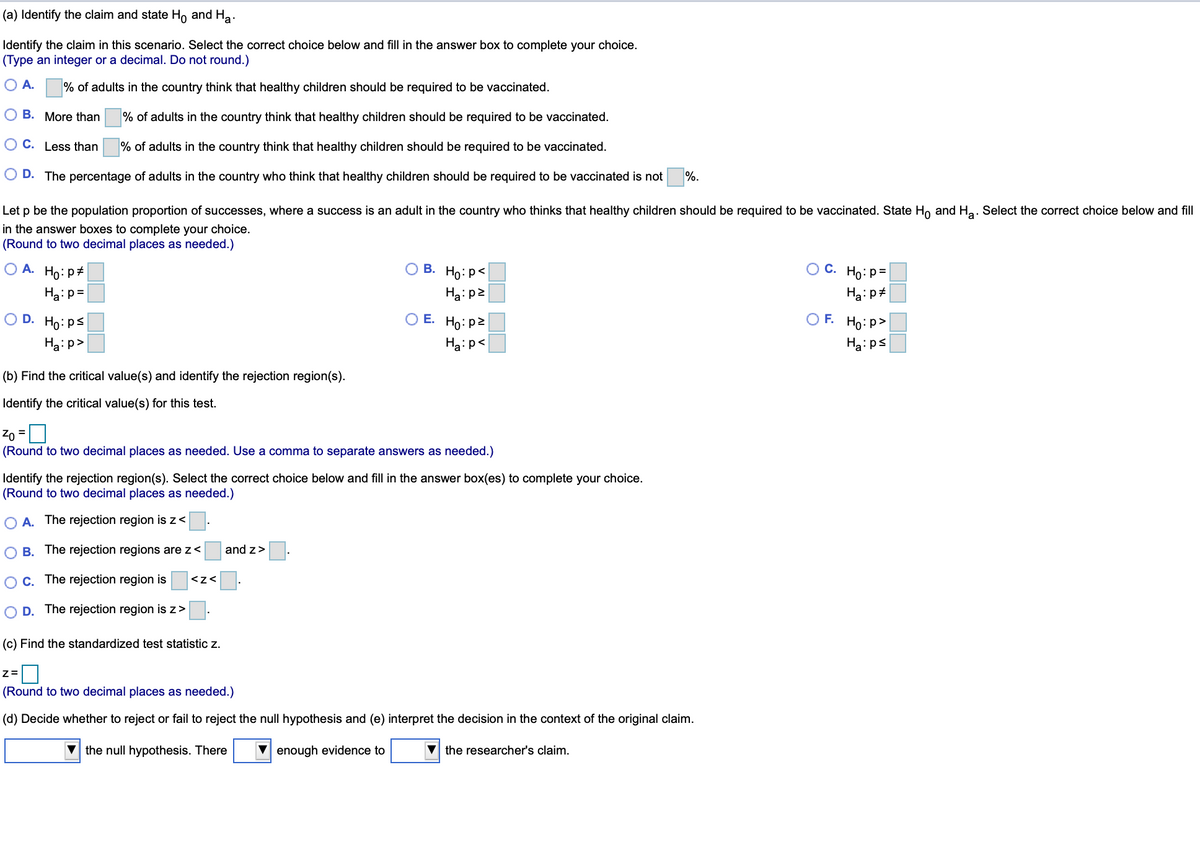A medical researcher says that less than 79% of adults in a certain country think that healthy children should be required to be vaccinated. In a random sample of 300 adults in that country, 75% think that healthy children should be required to be vaccinated. At α=0.01, is there enough evidence to support the researcher's claim? Complete parts (a) through (e) below.
A medical researcher says that less than 79% of adults in a certain country think that healthy children should be required to be vaccinated. In a random sample of 300 adults in that country, 75% think that healthy children should be required to be vaccinated. At α=0.01, is there enough evidence to support the researcher's claim? Complete parts (a) through (e) below.
College Algebra (MindTap Course List)
12th Edition
ISBN:9781305652231
Author:R. David Gustafson, Jeff Hughes
Publisher:R. David Gustafson, Jeff Hughes
Chapter8: Sequences, Series, And Probability
Section8.CR: Chapter Review
Problem 69E: In how many ways can 10 teenagers be seated at a round table if 2 girls wish to sit with their...
Related questions
Topic Video
Question
A medical researcher says that less than 79% of adults in a certain country think that healthy children should be required to be vaccinated. In a random sample of 300 adults in that country, 75% think that healthy children should be required to be vaccinated. At α=0.01, is there enough evidence to support the researcher's claim? Complete parts (a) through (e) below.

Transcribed Image Text:(a) Identify the claim and state Ho and Ha.
Identify the claim in this scenario. Select the correct choice below and fill in the answer box to complete your choice.
(Type an integer or a decimal. Do not round.)
O A.
% of adults in the country think that healthy children should be required to be vaccinated.
B. More than
% of adults in the country think that healthy children should be required to be vaccinated.
C. Less than
% of adults in the country think that healthy children should be required to be vaccinated.
D. The percentage of adults in the country who think that healthy children should be required to be vaccinated is not
%.
Let p be the population proportion of successes, where a success is an adult in the country who thinks that healthy children should be required to be vaccinated. State Ho and Ha. Select the correct choice below and fill
in the answer boxes to complete your choice.
(Round to two decimal places as needed.)
O A. Ho: p#
O B. Ho:p<
С. Но: р3
Ha:p=
Ha:p2
O D.
Ho:ps
O E. Ho: p2
O F. Ho: p>
Ha:p>
Ha:p<
Ha:ps
(b) Find the critical value(s) and identify the rejection region(s).
Identify the critical value(s) for this test.
Zo =U
(Round to two decimal places as needed. Use a comma to separate answers as needed.)
%3D
Identify the rejection region(s). Select the correct choice below and fill in the answer box(es) to complete your choice.
(Round to two decimal places as needed.)
A. The rejection region is z<
B. The rejection regions are z<
and z>
C. The rejection region is
<z<
D. The rejection region is z>
(c) Find the standardized test statistic z.
(Round to two decimal places as needed.)
(d) Decide whether to reject or fail to reject the null hypothesis and (e) interpret the decision in the context of the original claim.
V the null hypothesis. There
enough evidence to
V the researcher's claim.
OO ON
OO DO
Expert Solution
This question has been solved!
Explore an expertly crafted, step-by-step solution for a thorough understanding of key concepts.
This is a popular solution!
Trending now
This is a popular solution!
Step by step
Solved in 4 steps with 2 images

Knowledge Booster
Learn more about
Need a deep-dive on the concept behind this application? Look no further. Learn more about this topic, statistics and related others by exploring similar questions and additional content below.Recommended textbooks for you

College Algebra (MindTap Course List)
Algebra
ISBN:
9781305652231
Author:
R. David Gustafson, Jeff Hughes
Publisher:
Cengage Learning

College Algebra (MindTap Course List)
Algebra
ISBN:
9781305652231
Author:
R. David Gustafson, Jeff Hughes
Publisher:
Cengage Learning